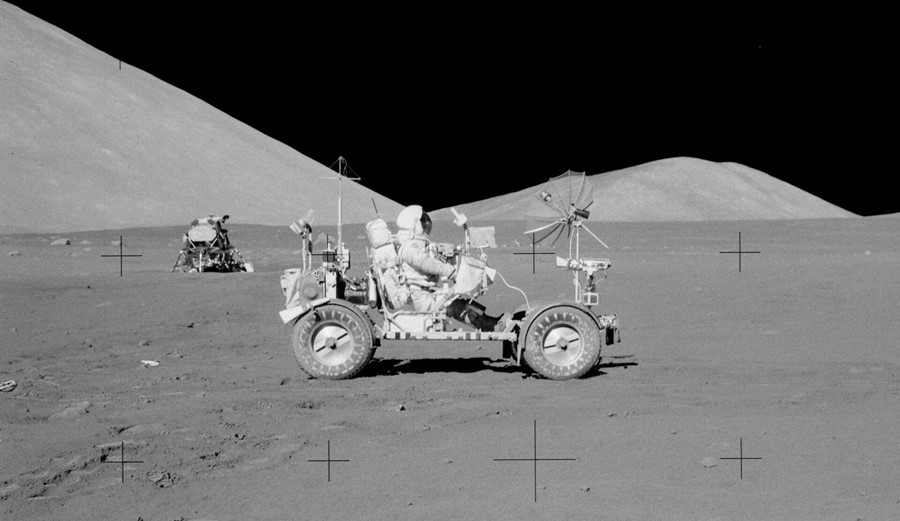The European Space Agency plans to melt roads into the moon with concentrated sunlight – but why?
Scientists recently revealed plans to melt the moon. And no, these plans are not the brainchild of mad scientists, or evil supervillains bent on throwing Earth off its axis, but the European Space Agency (ESA), which says that reshaping the moon’s rocky surface with super powerful lasers might be the key to future habitation.
You might remember NASA’s bold claim that humans could live on the moon by 2040 from earlier this month. Before that, though – as early as 2025 – the space agency’s Artemis mission is set to take astronauts on shorter trips to the lunar surface, where they’ll put space boots on the ground for the first time since the 70s. With millionaires already flying into low Earth orbit for fun, lunar tourism is also an imminent prospect.
All of this leaves spaceflight engineers with a number of problems to solve, from how to safely transport civilians to the moon, to how they’re going to get about once they’re up there. Put forward by ESA, the plans to melt the moon will apparently provide a solution to the latter, creating “roads” for lunar vehicles to drive on.
How will the lasers work? Why is it so important to smooth out the moon in the first place? Is carving roads into the moon more or less sacrilegious than cutting a dual carriageway through Stonehenge? Find out below.
WHY WOULD WE WANT TO MELT THE MOON?
In a recent article about making roads on the moon, the ESA explains that previous missions have been hampered by billowing moondust. This is toxic to humans and very sticky, since it’s electrically charged by constant radiation from the sun. It’s also very abrasive. In the Apollo era, it eroded spacesuits and clogged up important machinery. Any permanent structures we put up in the future could fare even worse.
Minimising the amount of moondust floating around – often kicked up by landing spacecraft – is an obvious necessity if we want to establish any kind of long-term presence on the moon. One way to do this is by paving over the surface, especially in places where spacecraft touch down or vehicles traverse the cratered landscape.
SO WHERE DO THE LASERS COME IN?
A problem with paving over the moon is that it would be very difficult (or costly) to transport the kinds of materials we use on Earth. NASA recently experimented with the idea of 3D-printing structures out of “concrete” made from moondust itself, and ESA’s plan would similarly make use of the materials at hand.
More specifically, the agency’s PAVER (“paving the road for large area sintering of regolith”) project involves melting patches of moondust down using the power of the sun, focused through a lens measuring just a couple of metres across. An interlocking pattern of this melted lunar material could theoretically form a hard surface for roads or landing pads.

WILL IT ACTUALLY WORK, THOUGH?
The scientists behind PAVER have already started testing its feasibility here on Earth. Using an artificial version of lunar soil, they’ve managed to form a “glassy solid surface” – the kind that could be used to pave the moon – by blasting it with a 12-kilowatt carbon dioxide laser.
“In practice, we would not bring a carbon dioxide laser on the moon,” says ESA materials engineer Advenit Makaya in a statement. (Of course, that would be crazy. Better find a different way to melt the moon.) “Instead,” he adds, “this current laser is serving as a light source for our experiments, to take the place of lunar sunlight which could be concentrated [...] to produce equivalent melting on the surface of the Moon.”
Either way, the results are looking promising (if you’re into melting the moon). “The resulting material is glasslike and brittle, but will mainly be subject to downward compression forces,” Makaya adds. “Even if it breaks we can still go on using it, repairing it as necessary.”
SO WE CAN MAKE ROADS ON THE MOON, BUT SHOULD WE?
So far, humanity’s destructive practices have mostly been confined to our own world. An exception to this is DART, the 2022 NASA and SpaceX mission that crashed a spacecraft into an asteroid to knock it off course. This mission was largely considered a success, but it also had its critics. “The idea of being able to move, and exploit, and destroy or change natural capital like rocks and asteroids is very fundamentally pinned to an imperial worldview that sees humans as being allowed to do whatever they want,” said Ellie Armstrong, an outer space geographer at the University of Delaware, at the time.
The same criticism could no doubt be levelled at humans trying to modify the moon according to their own needs, like mining, or tourism, or just to show off their technological might. After all, do you really want to go out one clear night and discover the man in the moon has a motorway tattooed across his face?
Another common criticism of space missions like PAVER is that they distract from essential developments on our home planet, where (lest we forget) we’re still facing a climate crisis, global conflict, and the possibility of future pandemics. Others argue that technological breakthroughs designed for space can also be applied on Earth, though. Could melting roads into the surface of Earth be the future of materially cheap travel infrastructure? Maybe! Or maybe we can take it even further – let’s melt it all down, the whole solar system, and finally surrender ourselves to the cosmic soup.
Join Dazed Club and be part of our world! You get exclusive access to events, parties, festivals and our editors, as well as a free subscription to Dazed for a year. Join for £5/month today.




